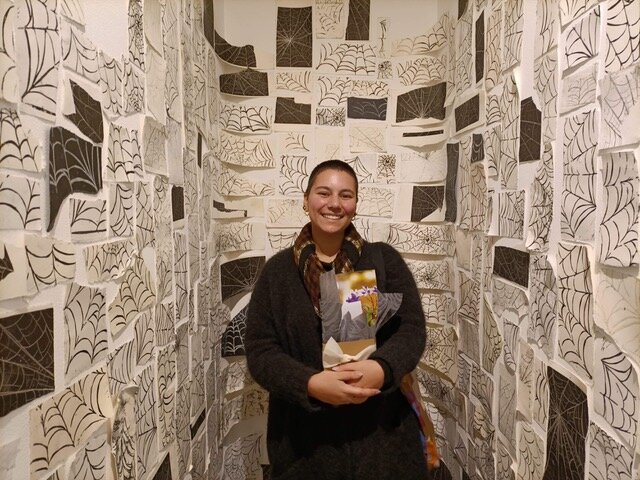Photography by Caitlyn Mulligan.
Sarah Catania
Sarah Catania draws on her own life experiences to create works that engage with trauma, loss, grief and memory. Using different mediums to explore the impact of her own psychological struggles, she reflects on the consequences of negative experiences in her own life which have impacted her. Catania uses artwork as a way to process life and give expression to inner monologue.
She has recently completed a Bachelor of Fine Arts at UNSW and is currently studying a Masters of Fine Art at RMIT.
Tell us about your creative process, what drives your practice?
I think experimentation drives my practice a lot, especially in printmaking. I really enjoy responding to whatever happens during the process, mistakes or not, and finding a way to include that into the final iteration of the work.
Personal experience also drives my work. If there is an event or emotion I want to explore further, I’ll find a way to make something from it.
You don’t shy away from complex and confronting themes such as trauma, loss and grief in your practice, and this act of exposing your feelings can leave the audience feeling vulnerable or uneasy. Can you tell us more about how affect and discomfort operate within your practice?
I don’t specifically aim to make the audience feel uneasy or uncomfortable with my work, rather I aim to explain my emotions or experiences in a way that others could also relate to. A lot of the time I’ll feel uncomfortable making the work, so I focus on the process and think about it conceptually in short bursts when I need to connect it or make a new direction for it. I think that these themes of trauma, loss and grief are things that need to be worked through, and I always hope that someone in the audience can find some sort of peace when viewing my work or that they can relate to it.
Your work often breaks out of the confines of the ‘editioned print’. What draws you to these more spatial and sculptural approaches to art making?
I think that for me, the process of the work is really important, because a lot of the time I’ll make mistakes and respond to it, so the work just keeps growing until it turns into something larger than a print.
I’ve found that I also have trouble expressing my themes or experiences in a single print. A lot of the larger more sculptural works explore the feeling of overwhelm or something I feel like dominates my space, so making the works large and encasing makes sense to me, it’s a way to physically invite the audience into my mind and emotions at the time. I find the physicality of installations really interesting, that the audience gets to control their own experience with the works, and I think that’s really cool!
Are there any female printmakers | artists that influence you?
I had the pleasure of having Rebecca O’Shea as one of the printmaking studio technicians when I was doing my bachelor. She’s an amazing printmaker and problem solver and has helped me with my work so much!
I learnt the foundational skills of lithography from Jacqui Driver – her work is absolutely beautiful, she is a brilliant lithographer!
I also look to Louise Bourgeois, Tracey Emin and more recently, Pia Interlandi to name a few more.
Finally, what exciting projects are you working on at the moment?
At the moment I’m experimenting with natural dyeing, using found fabric and incorporating more sewing into my printmaking practice. I’ve also been doing all my printmaking at home, so I’ve been trying out different ways to print using what I have on hand which has been really fun!

